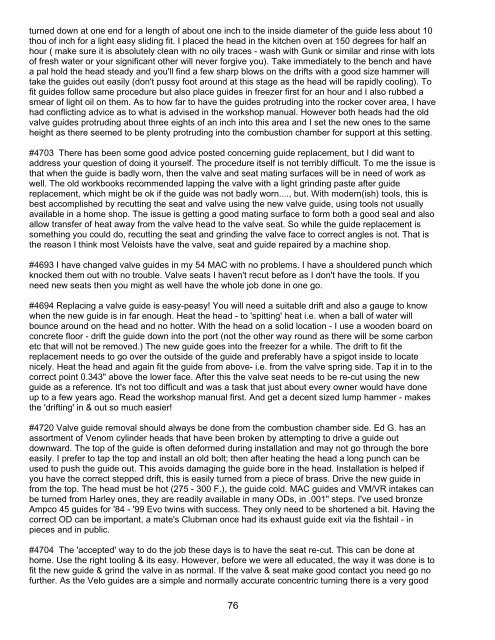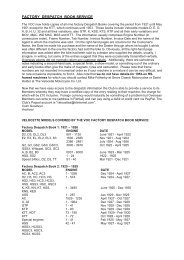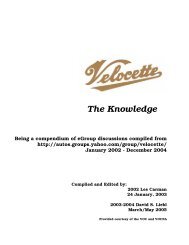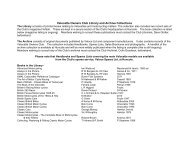The Knowledge - Velocette Owners Club
The Knowledge - Velocette Owners Club
The Knowledge - Velocette Owners Club
You also want an ePaper? Increase the reach of your titles
YUMPU automatically turns print PDFs into web optimized ePapers that Google loves.
turned down at one end for a length of about one inch to the inside diameter of the guide less about 10<br />
thou of inch for a light easy sliding fit. I placed the head in the kitchen oven at 150 degrees for half an<br />
hour ( make sure it is absolutely clean with no oily traces - wash with Gunk or similar and rinse with lots<br />
of fresh water or your significant other will never forgive you). Take immediately to the bench and have<br />
a pal hold the head steady and you'll find a few sharp blows on the drifts with a good size hammer will<br />
take the guides out easily (don't pussy foot around at this stage as the head will be rapidly cooling). To<br />
fit guides follow same procedure but also place guides in freezer first for an hour and I also rubbed a<br />
smear of light oil on them. As to how far to have the guides protruding into the rocker cover area, I have<br />
had conflicting advice as to what is advised in the workshop manual. However both heads had the old<br />
valve guides protruding about three eights of an inch into this area and I set the new ones to the same<br />
height as there seemed to be plenty protruding into the combustion chamber for support at this setting.<br />
#4703 <strong>The</strong>re has been some good advice posted concerning guide replacement, but I did want to<br />
address your question of doing it yourself. <strong>The</strong> procedure itself is not terribly difficult. To me the issue is<br />
that when the guide is badly worn, then the valve and seat mating surfaces will be in need of work as<br />
well. <strong>The</strong> old workbooks recommended lapping the valve with a light grinding paste after guide<br />
replacement, which might be ok if the guide was not badly worn...., but. With modern(ish) tools, this is<br />
best accomplished by recutting the seat and valve using the new valve guide, using tools not usually<br />
available in a home shop. <strong>The</strong> issue is getting a good mating surface to form both a good seal and also<br />
allow transfer of heat away from the valve head to the valve seat. So while the guide replacement is<br />
something you could do, recutting the seat and grinding the valve face to correct angles is not. That is<br />
the reason I think most Veloists have the valve, seat and guide repaired by a machine shop.<br />
#4693 I have changed valve guides in my 54 MAC with no problems. I have a shouldered punch which<br />
knocked them out with no trouble. Valve seats I haven't recut before as I don't have the tools. If you<br />
need new seats then you might as well have the whole job done in one go.<br />
#4694 Replacing a valve guide is easy-peasy! You will need a suitable drift and also a gauge to know<br />
when the new guide is in far enough. Heat the head - to 'spitting' heat i.e. when a ball of water will<br />
bounce around on the head and no hotter. With the head on a solid location - I use a wooden board on<br />
concrete floor - drift the guide down into the port (not the other way round as there will be some carbon<br />
etc that will not be removed.) <strong>The</strong> new guide goes into the freezer for a while. <strong>The</strong> drift to fit the<br />
replacement needs to go over the outside of the guide and preferably have a spigot inside to locate<br />
nicely. Heat the head and again fit the guide from above- i.e. from the valve spring side. Tap it in to the<br />
correct point 0.343" above the lower face. After this the valve seat needs to be re-cut using the new<br />
guide as a reference. It's not too difficult and was a task that just about every owner would have done<br />
up to a few years ago. Read the workshop manual first. And get a decent sized lump hammer - makes<br />
the 'drifting' in & out so much easier!<br />
#4720 Valve guide removal should always be done from the combustion chamber side. Ed G. has an<br />
assortment of Venom cylinder heads that have been broken by attempting to drive a guide out<br />
downward. <strong>The</strong> top of the guide is often deformed during installation and may not go through the bore<br />
easily. I prefer to tap the top and install an old bolt; then after heating the head a long punch can be<br />
used to push the guide out. This avoids damaging the guide bore in the head. Installation is helped if<br />
you have the correct stepped drift, this is easily turned from a piece of brass. Drive the new guide in<br />
from the top. <strong>The</strong> head must be hot (275 - 300 F.), the guide cold. MAC guides and VM/VR intakes can<br />
be turned from Harley ones, they are readily available in many ODs, in .001" steps. I've used bronze<br />
Ampco 45 guides for '84 - '99 Evo twins with success. <strong>The</strong>y only need to be shortened a bit. Having the<br />
correct OD can be important, a mate's <strong>Club</strong>man once had its exhaust guide exit via the fishtail - in<br />
pieces and in public.<br />
#4704 <strong>The</strong> 'accepted' way to do the job these days is to have the seat re-cut. This can be done at<br />
home. Use the right tooling & its easy. However, before we were all educated, the way it was done is to<br />
fit the new guide & grind the valve in as normal. If the valve & seat make good contact you need go no<br />
further. As the Velo guides are a simple and normally accurate concentric turning there is a very good<br />
76





